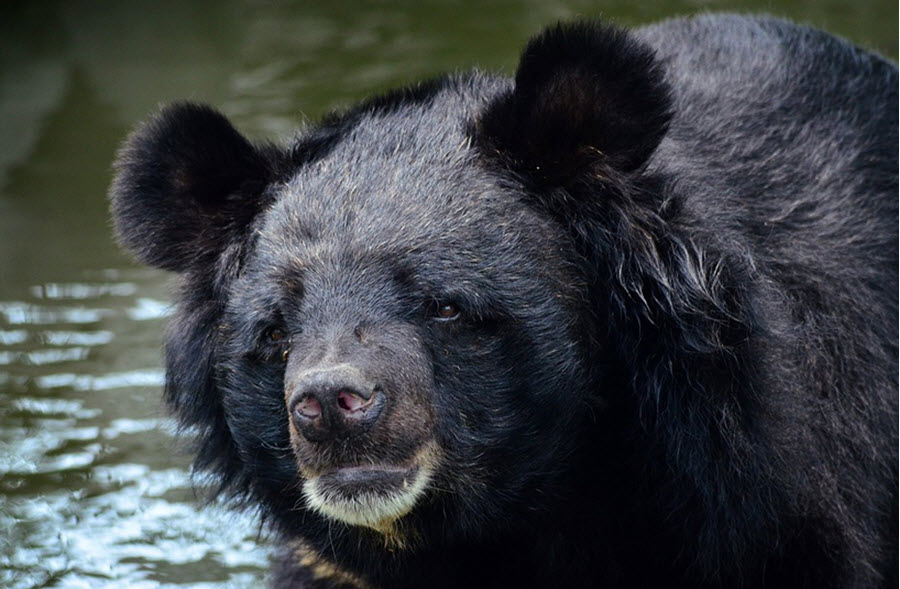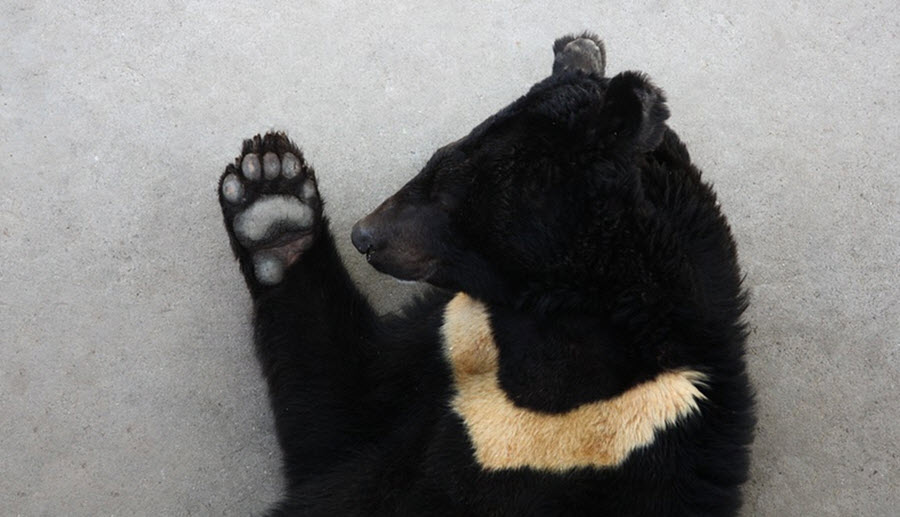Contents
The Asian black bear is a medium-sized bear native to Asia, where it lives in the forest.

The Asian black bear is also known as Moon bear, White-chested bear, and Asiatic black bear.
Its scientific name used to be Selenarctos thibetanus, but is now Ursus thibetanus.
This species is considered vulnerable, which is milder than endangered. The two main threats are deforestation and hunting for body parts (to make non-scientific medicines).
Where?
Examples of places where you can encounter Asian black bears:
- The northern parts of the Indian subcontinent
- The Himalayas
- North-eastern China
- Taiwan
- The Korean peninsula
- The Russian Far East
- The islands Honshū and Shikoku in Japan
Behaviour
Asian black bears are normally diurnal, but individuals who live near human settlements can become nocturnal to avoid interactions with humans.
They are often seen in small family groups consisting of two adults and two successive litters of offspring. If there is enough food around, they can remain in a fairly small area of two square kilometres or even less.
The Asian black bear is a skilled climber of both trees and rocks, although some adults grow so heavy that they stop climbing. An average Asian black bear will spend a lot of its time in the trees, where it can forage for food, take nap and get away from hazards. This bear is heavy compared to most other arboreal species, and it is also strong enough to break branches and use them to construct nest-like resting spots high up in the trees.
Hibernation
This species of bear will hibernate if necessary, but in most parts of its range hibernation is not required since the winters aren´t very harsh. Also, some individuals will simply migrate to a warmer location in the fall. Bears who have spent to the summer at high altitude in the mountains can walk down to lower elevations and spend the winter season there.
Notably, pregnant Moon bears will usually prepare a den even when hibernation isn´t required because of the wheather.
Hibernation dens
Asian black bears utilize varying den-styles and can for instance elect to sleep in caves, abandoned brown bear dens, holes in the ground, hollow logs, or dug-out hollow trees far above the ground. Some prefer a steep and sunny slope in the mountains.
The males end hibernation before the females, and females with cubs stay in their dens longer than females without cubs.
Scientific classification
| Kingdom: | Animalia |
| Phylum: | Chordata |
| Class: | Mammalia |
| Order: | Carnivora |
| Family: | Ursidae |
| Genus: | Ursus |
| Species: | Ursus thibetanus |

Subspecies
| Scientific name | Common English name | Information |
| Ursus thibetanus formosanus R. Swinhoe, 1864 | Formosan black bear | Lives in Taiwan Unlike most other subspecies, it doesn´t have thick neck fur. |
| Ursus thibetanus gedrosianus Blanford, 1877 | Balochistan black bear Also known as Pakistan black bear | Lives in southern Balochistan, an arid and mountainous region in south-western Asia. Has a relatively short, coarse fur. Tends to be reddish-brown rather than black.
|
| Ursus thibetanus japonicus Schlegel, 1857 | Japanese black bear | Lives on Honshū and Shikoku in Japan. Extinct on Kyushu.
Unlike most other subspecies, it doesn´t have thick neck fur. It stays rather small and the snout is dark. |
| Ursus thibetanus laniger Pocock, 1932 | Himalayan black bear | Lives in the Himalayas, Kashmir and Sikkim.
Lives at higher altitudes in the summer (3,000 – 3,600 m) and descend to warmer regions for the winter season (but usually not below 1,500 m).
Compared this U. t. thibetanus, this subspecies has longer and thicker fur, and the chestmark is both whiter and smaller. |
| Ursus thibetanus mupinensis Heude, 1901
| Indochinese black bear | Lives in the Himalayas and Indochina
Has comparatively light-coloured fur. |
| Ursus thibetanus thibetanus Cuvier, 1823 | Tibetan black bear | Lives on the Qinghai-Tibet Plateau and in Assam, Nepal, Thailand, Annam, and Myanmar/Burma (including the Mergui archipelago)
Unlike the Himalayan black bears, this subspecies has a short, thin coat with litte to no underwool. |
| Ursus thibetanus ussuricus Heude, 1901 | Ussuri black bear | Lives in southern Siberia, northeastern China and on the Korean peninsula
Grows larger than the other subspecies. |
Until Late Pleistocene, Ursus thibetanus lived in Europe and Western Asia as well. The subspecies U. t. mediterraneus lived in western Europe and the Caucasus, while the subspecies U. t. permjak inhabited eastern Europe, including the Ural Mountains.
